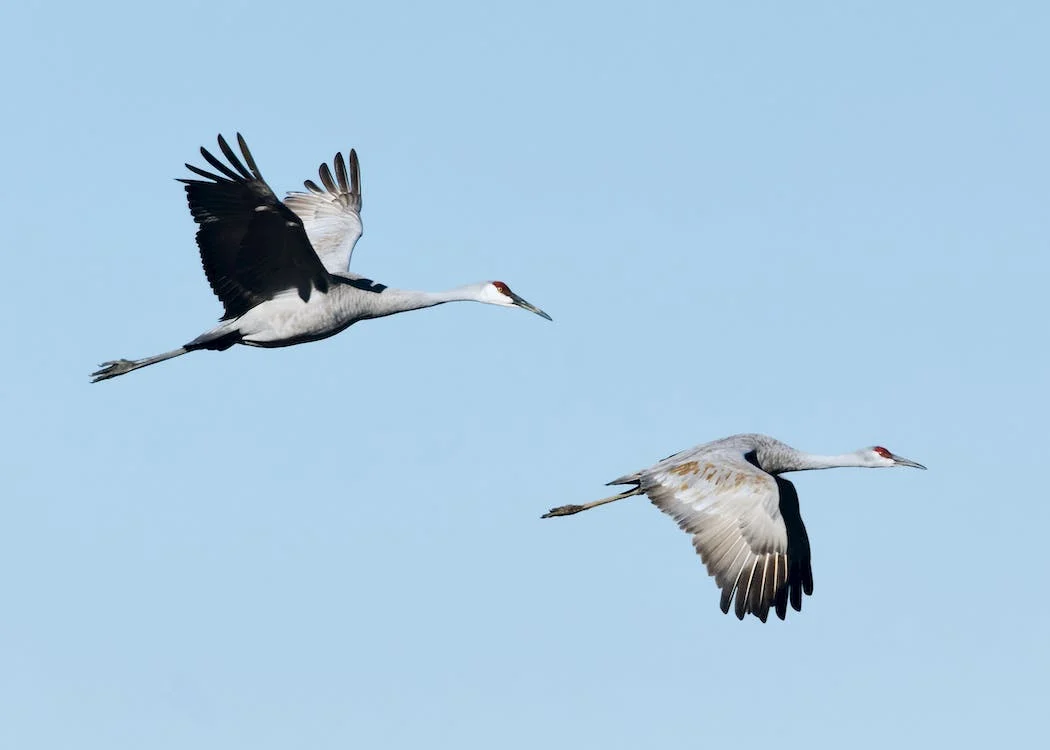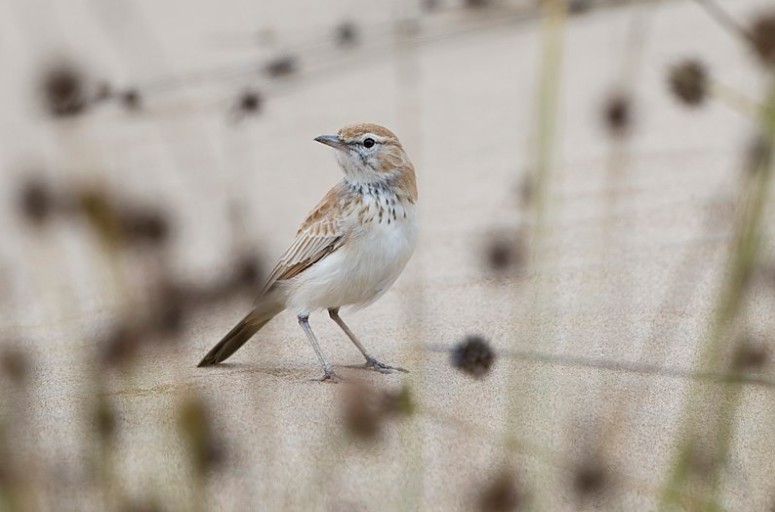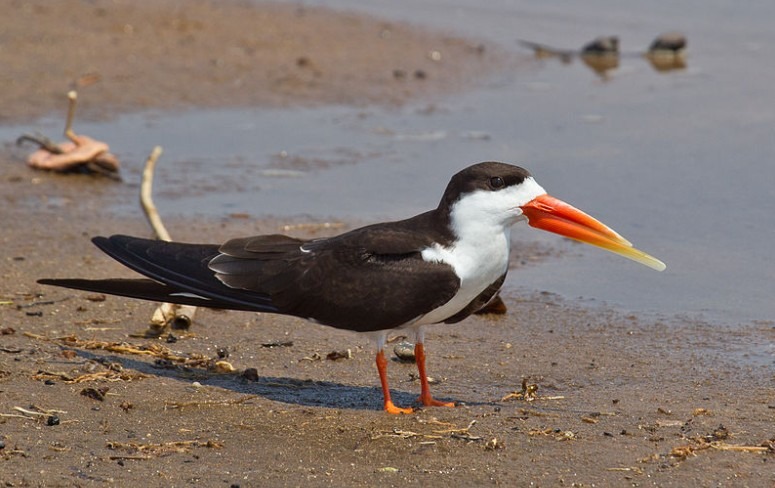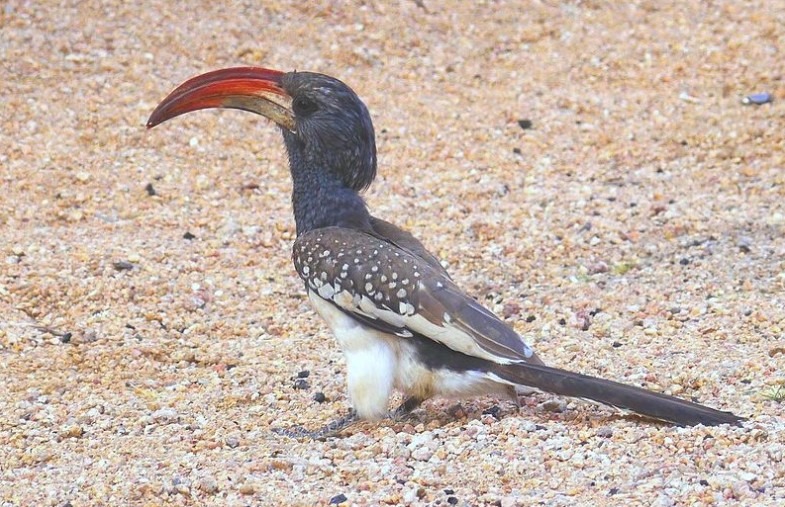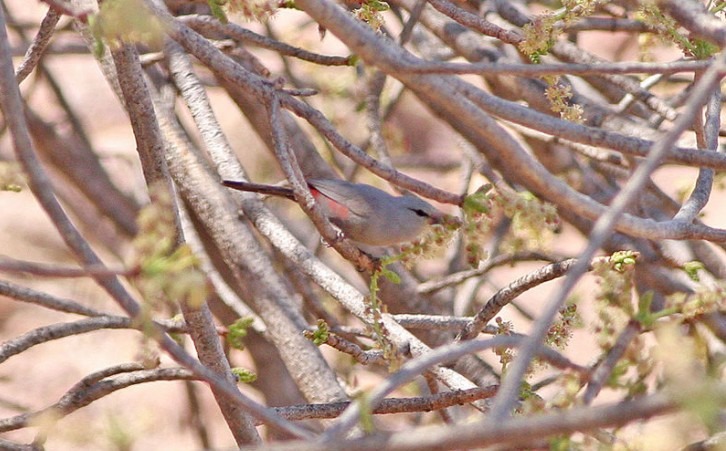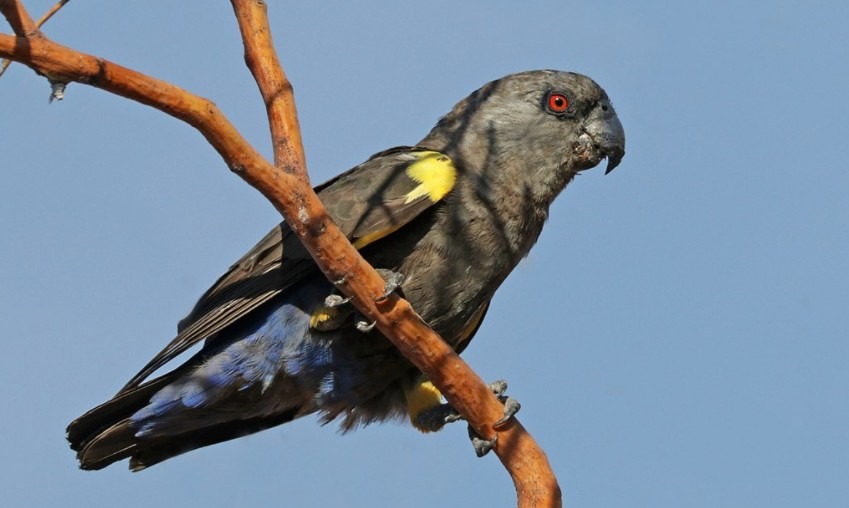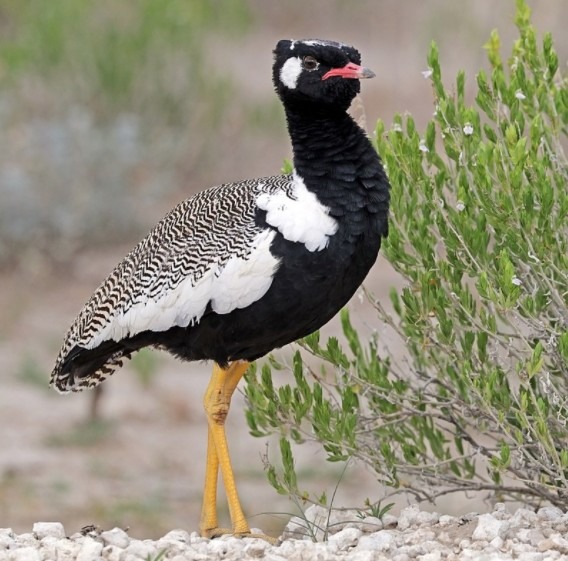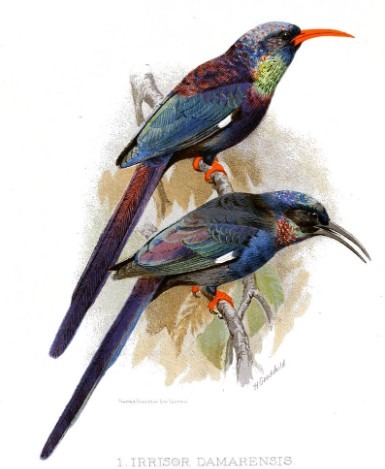When it comes to Africa, Namibia is the favorite of many. It is one of the most spectacular locations on the planet due to its splendid landscapes and diverse habitats. Here, you will find around 676 species of birds. If you happen to be a bird lover then this is heaven for you. People like Namibia due to its relaxed climate, cool nights, warm days, and almost zero humidity.
The same reason goes for the birds and different animal species as well. For them, this is the perfect place to give birth to their young ones, feed and look after them as well. Namibia is known as a country that is full of surprises. Every inch of the country has something to offer, which cannot be missed. Furthermore, the people of Namibia are friendly and specialize in entertaining thousands of visitors that visit the country each year. When you are in Namibia, expect to see some very exotic and rare bird species. Let’s take a look at them.
Dune Lark
The first amongst very rare bird species is Dune Lark. It is only found in Namibia and nowhere else in the world. Since the Namib is the oldest desert in the world, it has evolved over time, which has ultimately resulted in the evolution of habitats to better suit the adaption of Dune Lark. The most amazing thing about these birds is that they do not drink water. They fulfill their water requirement from the insects and seeds consumed. If you wish to catch a glimpse of Dune Larks, look for them while they are running up and down the dune sides. Since these birds are very rare, they are mostly found in protected areas such as the Namib-Naukluft Park.
African Skimmer
The quest of African Skimmer will drive you away from Namibia desert and make you end up in the Caprivi Strip. This bird is a migrator that travels within the continent and features extensive reach. However, due to diminishing habitat and unrest, the African Skimmer has become endangered and threatened. You shall only find this bird at the Caprivi Strip, where they showcase their fish hunting abilities. The best time to catch a glimpse of these birds is evening as they mostly feed at night. Conservationists and relevant authorities have been trying to devise a plan to protect this endangered specie. If it is gone, it is gone forever.
Montiero’s Hornbill
Montiero’s Hornbill needs very little water to survive. Reason being that these birds prefer to live in dry places such as savannahs and desert-like habitats. Therefore, they satisfy their thirst from the moisture included in arthropods and insects they eat. Furthermore, it is a specie that is only found in Namibia with a population of over 340,000 individuals.
The Montiero’s Hornbill is a medium-sized bird that is identified by a white belly with white spots both on flight feathers and wings. Furthermore, it features a red beak and black eyes. Most people are not aware of the fact that the Montiero’s Hornbill is a smart bird specie. They use their feces to seal themselves inside their nests. However, this could be harmful to their health. But with time Montiero’s have found out that certain insects consist of antibiotic properties that can be squashed and spread around to protect themselves and their young ones.
Cinderella Waxbill
The Cinderella Waxbill is yet another birdspecie that is near-threatened. Like the Montiero’s Hornbill, the Cinderella Waxbill also prefers savannah, dry shrubland with the addition of both tropical and subtropical areas. This bird was mostly found at the Cunene River at Epupa Falls, however, due to the construction of a hydroelectric plant, the insects on which these birds relied on as food has diminished as well.
These insects were used by Cinderella Waxbills to feed their young and now since the population has declined, Cinderella Waxbills find it really hard to survive. Eventually, relevant authorities will have to take up this issue if we really wish to save these birds from extinction.
Ruppell’s Parrot
Although the Ruppell’s Parrot is an exotic bird specie native to Namibia but it is also found as a caged pet around the world, which is a sad reality. The Ruppell’s Parrot is known for its friendly nature and attractive physical features. You will find advertisements all over the internet regarding Ruppell’s Parrot as an exotic caged pet. Its demand has risen up to the point where it is also illegally trafficked.
Furthermore, Ruppell’s Parrot is also facing another serious challenge and that is related to survival. Changing climate now brings less amount of rain each year to Namibia. These parrots are directly linked to these rains and since Namibia remains dry mostly throughout the year, the Ruppell’s Parrot is finding it hard to make it through.
Northern Black Korhaan
The Northern Black Korhaan is one of the finest examples of the amazing bird show in Namibia. Also known as, the white-quilled bustard, the Northern Black Korhaan prefers scrub and open grassland. Although it is a bird that prefers to mostly remain on the ground but when disturbed, it could take a flight. These birds tend to make quick movements and if an intruder is observed, the Northern Black Korhaan emits a loud sound while running away and extending both the neck and head.
Furthermore, it feeds on beetles, grasshoppers, ants, and termites. While the male is a usual sight, the females on the other hand are seldom seen.
Violet Wood Hoopoe
We wish we could introduce this beautiful bird without its endangered status. The reality is that the Violet Wood Hoope is a severely fragmented bird specie and is experiencing a decrease in population. Furthermore, these birds tend to be co-operative and will help others Hoopoes to find food for their chicks. Namibia consists of only 500 breeding pairs of the total 1,650 around the world. This raises a serious concern regarding their population.
The Violet Wood Hoopoe could only be seen in sunlight when its striking red beak along with violet and white color combination shines due to reflection. It is a bird that features one of the most unique color combinations.
Final Word
This concludes our list of the most exotic birds existing in Namibia. It needs to be remembered that birds in Namibia are spread depending on the type. If you wish to catch a glimpse of a particular species, you will have to visit the area where it is mostly found. This way you will be able to observe them in their pure wild nature. And, don’t be disappointed if you are not able to find your favorite specie or species. With 676 species to offer, many more will make up for it.
BOTSWANA BIRDS | SOUTHERN AFRICA BIRDS | SOUTH AFRICA BIRDS | ZIMBABWE BIRDS | ZAMBIA BIRDS
COMMON MAMMALS | COMMON TREES | WILDLIFE PARKS | HOME
Abdim’s Stork
African Black Duck
African Broadbill
African Crake
African Cuckoo
African Finfoot
African Fish Eagle
African Golden Oriole
African Goshawk
African Hawk Eagle
African Hobby
African Jacana
African Marsh Harrier
African Marsh Warbler
African Pied Wagtail
African Rail
African Sedge Warbler
African Skimmer
African Spoonbill
Alpine Swift
American Purple Gallinule
Angola Pitta
Angola Swallow
Antarctic Tern
Ant-eating Chat
Arctic Skua
Arctic Tern
Arnot’s Chat
Arrow-marked Babbler
Ashy Tit
Augur Buzzard
Ayres’ Eagle
Baillon’s Crake
Baird’s Sandpiper
Banded Martin
Bank Cormorant
Bar-tailed Godwit
Bare-cheeked Babbler
Barlow’s Lark
Barn Owl
Barred Owl
Barred Warbler
Bat Hawk
Bateleur
Bearded Robin
Bearded Woodpecker
Bennett’s Woodpecker
Bittern
Black-backed Cisticola
Black-bellied Korhaan
Black-breasted Snake Eagle
Black-cheeked Lovebird
Black-cheeked Waxbill
Black-chested Prinia
Black-collared Barbet
Black-crowned Night-Heron
Black-crowned Tchagra
Black-eared Canary
Black-eared FinchLark
Black-eyed Bulbul
Black-faced Babbler
Black-headed Canary
Black-headed Gull
Black-headed Heron
Black-headed Oriole
Black-necked Grebe
Black-shouldered Kite
Black-tailed Godwit
Black-throated Canary
Black-winged Pratincole
Black-winged Stilt
Black Coucal
Black Crake
Black Crow
Black Cuckoo
Black Cuckoo-Shrike
Black Eagle
Black Egret
Black Flycatcher
Black Harrier
Black Korhaan
Black Oystercatcher
Black Saw-wing Swallow
Black Sparrowhawk
Black Stork
Black Sunbird
Black Swift
Black Tern
Blackbrowed Albatross
Blacksmith Plover
Bleating Warbler
Blue-cheeked Bee-eater
Blue-grey Flycatcher
Blue Crane
Blue Waxbill
Boehm’s Spinetail
Bokmakierie
Booted Eagle
Bradfield’s Hornbill
Bradfield’s Swift
Bridled Tern
Broad-billed Prion
Broad-billed Roller
Broad-billed Sandpiper
Broad-tailed Paradise Whydah
Bronze-winged Courser
Bronze Mannikin
Brown-hooded Kingfisher
Brown-throated Martin
Brown-throated Weaver
Brown Firefinch
Brown Snake Eagle
Brubru
Buff-spotted Flufftail
Buffy Pipit
Burchell’s Coucal
Burchell’s Courser
Burchell’s Sandgrouse
Burchell’s Starling
Burnt-necked Eremomela
Cape Bunting
Cape Cormorant
Cape Eagle Owl
Cape Francolin
Cape Gannet
Cape Parrot
Cape Penduline Tit
Cape Reed Warbler
Cape Robin
Cape Shoveller
Cape Sparrow
Cape Teal
Cape Turtle Dove
Cape Vulture
Cape Wagtail
Cape Weaver
Cape White-eye
Capped Wheatear
Cardinal Woodpecker
Carmine Bee-eater
Carp’s Black Tit
Caspian Plover
Caspian Tern
Cattle Egret
Chat Flycatcher
Chestnut-backed FinchLark
Chestnut-banded Plover
Chestnut Weaver
Chinspot
Chirping Cisticola
Cinderella Waxbill
Cinnamon-breasted Warbler
Clapper Lark
Collared Flycatcher
Collared Palm Thrush
Collared Sunbird
Common Greenshank
Common Moorhen
Common Quail
Common Sandpiper
Common Tern
Common Waxbill
Coppery-tailed Coucal
Coppery Sunbird
Coqui Francolin
Corncrake
Cory’s Shearwater
Crested Barbet
Crested Francolin
Crested GuineafOwl
Crimson-breasted Shrike
Croaking Cisticola
Crowned Cormorant
Crowned Crane
Crowned Hornbill
Crowned Plover
Cuckoo Finch
Cuckoo Hawk
Curlew Sandpiper
Curlew
Cutthroat Finch
Damara Tern
Dark Chanting Goshawk
Darter
Desert Cisticola
Dickinson’s Kestrel
Didric Cuckoo
Double-banded Courser
Double-banded Sandgrouse
Dune Lark
Dusky Lark
Dusky Sunbird
Dwarf Bittern
Eastern Red-footed Falcon
Egyptian Goose
Egyptian Vulture
Eleonora’s Falcon
Emerald Cuckoo
Ethiopian Snipe
European Bee-eater
European Cuckoo
European Golden Oriole
European Marsh Harrier
European Marsh Warbler
European Nightjar
European Oystercatcher
European Reed Warbler
European Roller
European Sedge Warbler
European Shoveller
European Starling
European Storm Petrel
European Swallow
European Swift
European Wheatear
Fairy Flycatcher
Familiar Chat
Fan-tailed Flycatcher
Fawn-coloured Lark
Feral Pigeon
Fiery-necked Nightjar
Fiscal Shrike
Flappet Lark
Fork-tailed Drongo
Franklin’s Gull
Freckled Nightjar
Fuelleborn’s Longclaw
Fulvous Duck
Gabar Goshawk
Garden Warbler
Gargeney
Giant Eagle Owl
Giant Kingfisher
Glossy Ibis
Glossy Starling
Golden-backed Pytelia
Golden-breasted Bunting
Golden-tailed Woodpecker
Golden Bishop
Golden Pipit
Golden Weaver
Goliath Heron
Grass Owl
Gray’s Lark
Great Crested Grebe
Great Reed Warbler
Great Shearwater
Great Snipe
Great Sparrow
Great Spotted Cuckoo
Great White Egret
Greater Blue-eared Starling
Greater Flamingo
Greater Honeyguide
Greater Kestrel
Greater Striped Swallow
Greater Swamp Warbler
Green-backed Heron
Green-capped Eremomela
Green-spotted Dove
Green Pigeon
Green Sandpiper Grey-backed Cisticola
Grey-backed FinchLark
Grey-headed Albatross
Grey-headed Bush Shrike
Grey-headed Gull
Grey-headed Sparrow
Grey-hooded Kingfisher
Grey Heron
Grey Hornbill
Grey Kestrel
Grey Lourie
Grey Penduline Tit
Grey Phalarope
Grey Plover
Grey Wagtail
Greyrumped Swallow
Ground Hornbill
Groundscraper Thrush
Gull-billed Tern
Gymnogene
Hadeda Ibis
Half-collared Kingfisher
Hamerkop
Harlequin Quail
Hartlaub’s Francolin
Hartlaub’s Gull
Helmeted Guineafowl
Herero Chat
Heuglin’s Robin
Hobby
Honey Buzzard
Hooded Vulture
Hoopoe
Horus Swift
Hottentot Teal
House Martin
House Sparrow
Icterine Warbler
Jackal Buzzard
Jackass Penguin
Jacobin Cuckoo
Jameson’s Firefinch
Kalahari Robin
Karoo Chat
Karoo Eremomela
Karoo Korhaan
Karoo Lark
Karoo Robin
Kelp Gull
Kerguelen Petrel
Kittlitz’s Plover
Klaas’s Cuckoo
Knob-billed Duck
Knot
Knysna Lourie
Kori Bustard
Kurrichane ButtonQuail
Kurrichane Thrush
Lanner Falcon
Lappet-faced Vulture
Lark-like Bunting
Laughing Dove
Layards’s Warbler
Lesser Black-backed Gull
Lesser Black-winged Plover
Lesser Blue-eared Starling
Lesser Double-collared Sunbird
Lesser Flamingo
Lesser Gallinule
Lesser Golden Plover
Lesser Grey Shrike
Lesser Honeyguide
Lesser Jacana
Lesser Kestrel
Lesser Masked Weaver
Lesser Moorhen
Lesser Spotted Eagle
Lesser Striped Swallow
Lilac-breasted Roller
Lilian’s Lovebird
Little Banded Goshawk
Little Bee-eater
Little BitTern
Little Egret
Little Grebe
Little Sparrowhawk
Little Stint
Little Swift
Lizard Buzzard
Long-billed Crombec
Long-billed Lark
Long-billed Pipit
Long-crested Eagle
Long-legged Buzzard
Long-tailed Shrike
Long-tailed Skua
Long-tailed Starling
Long-toed Plover
Ludwig’s Bustard
Maccoa Duck
Malachite Kingfisher
Malachite Sunbird
Manx Shearwater
Marabou Stork
Marico Flycatcher
Marico Sunbird
Marsh Owl
Marsh Sandpiper
Martial Eagle
Masked Weaver
Melba Finch
Meyer’s Parrot
Milvus Kite
Mongolian Plover
Monotonous Lark
Montagu’s Harrier
Monteiro’s Hornbill
Mosque Swallow
Mountain Chat
Mountain Pipit
Mourning Dove
Mozambique Nightjar
namaqua Dove
namaqua Prinia
namaqua Sandgrouse
narina Trogon
natal Nightjar
natal Robin
neddicky Cisticola
Northern Giant Petrel
Northern Pintail
Olive-tree Warbler
Olive Bee-eater
Olive Thrush
Open-billed Stork
Orange-breasted Bush Shrike
Orange-breasted Waxbill
Orange River Francolin
Osprey
Ostrich
Ovambo Sparrowhawk
Painted Snipe
Pale-winged Starling
Pale Chanting Goshawk
Pallid Flycatcher
Pallid Harrier
Palm Swift
Palmnut Vulture
Paradise Flycatcher
Paradise Whydah
Pearl-breasted Swallow
Pearl-spotted Owl
Pectoral Sandpiper
Pel’s Fishing Owl
Pennant-winged Nightjar
Peregrine Falcon
Pied Avocet
Pied Babbler
Pied Barbet
Pied Crow
Pied Kingfisher
Pied Starling
Pin-tailed Whydah
Pink-backed Pelican
Pink-billed Lark
Pink-throated Longclaw
Pintado Petrel
Plain-backed Pipit
Plum-coloured Starling
Pomarine Skua
Pririt Batis
Puffback
Purple-banded Sunbird
Purple Gallinule
Purple Heron
Purple Roller
Purple WidowFinch
Pygmy Falcon
Pygmy Goose
Pygmy Kingfisher
Quail Finch
Racket-tailed Roller
Rattling Cisticola
Red-backed Shrike
Red-billed Buffalo Weaver
Red-billed Firefinch
Red-billed Francolin
Red-billed HelmetShrike
Red-billed Hornbill
Red-billed Oxpecker
Red-billed Quelea
Red-billed Teal
Red-billed Wood-hoopoe
Red-breasted Swallow
Red-capped Crombec
Red-capped Lark
Red-chested Cuckoo
Red-chested Flufftail
Red-crested Korhaan
Red-eyed Bulbul
Red-eyed Dove
Red-faced Cisticola
Red-faced Mousebird
Red-headed Finch
Red-headed Weaver
Red-knobbed Coot
Red-necked Falcon
Red-necked Francolin
Red-necked Phalarope
Red-shouldered Widow
Red-winged Pratincole
Red Bishop
Redshank
Reed Cormorant
Richard’s Pipit
Ringed Plover
River Warbler
Rock Bunting
Rock Kestrel
Rock Martin
Rock Pigeon
Rock Pratincole
Rockrunner
Roseate Tern
Ross’s Lourie
Rosy-faced Lovebird
Royal Tern
Ruddy Turnstone
Rueppell’s Korhaan
Rueppell’s Parrot
Ruff
Rufous-bellied Heron
Rufous-bellied Tit
Rufous-cheeked Nightjar
Rufous-eared Warbler
Rufous-naped Lark
Rufous-tailed Palm Thrush
Rufous-vented Warbler
Sabine’s Gull
Sabota Lark
Sacred Ibis
Saddle-billed Stork
Sand Martin
Sand Plover
Sanderling
Sandwich Tern
Scaly-feathered Finch
Scarlet-chested Sunbird
Scimitar-billed Wood-hoopoe
Sclater’s Lark
Scops Owl
Secretarybird
Senegal Coucal
Shaft-tailed Whydah
Sharp-billed Honeyguide
Sharp-tailed Starling
Short-toed Rock Thrush
Shy Albatross
Sickle-winged Chat
Slaty Egret
Slender-billed Honeyguide
Sociable Weaver
Sooty Falcon
Sooty Shearwater
Sousa’s Shrike
South African Cliff Swallow
South African Shelduck
Southern Black Tit
Southern Giant Petrel
Southern Grey Tit
Southern Pochard
Southern Yellow-billed Hornbill
Spectacled Weaver
Spikeheeled Lark
Spotted-backed Weaver
Spotted Crake
Spotted Dikkop
Spotted Eagle Owl
Spotted Flycatcher
Spotted Prinia
Spur-winged Goose
Squacco Heron
Stanley’s Bustard
Stark’s Lark
Steelblue WidowFinch
Steppe Buzzard
Steppe Eagle
Stierling’s Barred Warbler
Stone Chat
Streaky-breasted Flufftail
Striped Crake
Striped Cuckoo
Striped Kingfisher
Striped Pipit
Subantarctic Skua
Swainson’s Francolin
Swallow-tailed Bee-eater
Swamp Boubou
Swift Tern
Taita Falcon
Tawny Eagle
Tawnyflanked Prinia
Temminck’s Courser
Terek Sandpiper
Terrestrial Bulbul
Thick-billed Cuckoo
Thick-billed Lark
Thick-billed Weaver
Three-banded Courser
Three-banded Plover
Three-streaked Tchagra
Thrush Nightingale
Tinkling Cisticola
Tractrac Chat
Tree Pipit
Tropical Boubou
Trumpeter Hornbill
Violet-eared Waxbill
Violet Wood-hoopoe
Wahlberg’s Eagle
Wandering Albatross
Water Dikkop
Wattled Crane
Wattled Plover
Wattled Starling
Western Banded Snake Eagle
Western Red-footed Kestrel
Whimbrel
WhinChat
Whiskered Tern
White-backed Duck
White-backed Mousebird
White-backed Night-Heron
White-backed Vulture
White-bellied Sunbird
White-breasted Cormorant
White-breasted Cuckoo-Shrike
White-browed Robin
White-browed Sparrow Weaver
White-chinned Petrel
White-crowned Plover
White-crowned Shrike
White-faced Duck
White-faced Owl
White-fronted Bee-eater
White-fronted Plover
White-headed Vulture
White-necked Raven
White-rumped Babbler
White-rumped Swift
White-tailed Shrike
White-throated Canary
White-throated Swallow
White-winged Black Korhaan
White-winged Tern
White-winged Widow
White HelmetShrike
White Pelican
White Stork
Common Whitethroat
Willow Warbler
Wilson’s Phalarope
Wilson’s Storm Petrel
Wilson’s WidowFinch
Wire-tailed Swallow
Wood Owl
Wood Pipit
Wood Sandpiper
Woodland Kingfisher
Woolly-necked Stork
Yellow-bellied Bulbul
Yellow-bellied Eremomela
Yellow-billed Duck
Yellow-billed Egret
Yellow-billed Kite
Yellow-billed Oxpecker
Yellow-billed Stork
Yellow-breasted Apalis
Yellow-eyed Canary
Yellow-fronted Tinker Barbet
Yellow-nosed Albatross
Yellow-spotted Nicator
Yellow-throated Sandgrouse
Yellow-throated Sparrow
Yellow Canary
Yellow Wagtail
Yellow White-eye
Zitting Cisticola

